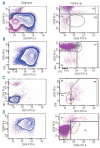Identification of residual leukemic cells by flow cytometry in childhood B-cell precursor acute lymphoblastic leukemia: verification of leukemic state by flow-sorting and molecular/cytogenetic methods
- PMID: 21933850
- PMCID: PMC3248943
- DOI: 10.3324/haematol.2011.051383
Identification of residual leukemic cells by flow cytometry in childhood B-cell precursor acute lymphoblastic leukemia: verification of leukemic state by flow-sorting and molecular/cytogenetic methods
Abstract
Reduction in minimal residual disease, measured by real-time quantitative PCR or flow cytometry, predicts prognosis in childhood B-cell precursor acute lymphoblastic leukemia. We explored whether cells reported as minimal residual disease by flow cytometry represent the malignant clone harboring clone-specific genomic markers (53 follow-up bone marrow samples from 28 children with B-cell precursor acute lymphoblastic leukemia). Cell populations (presumed leukemic and non-leukemic) were flow-sorted during standard flow cytometry-based minimal residual disease monitoring and explored by PCR and/or fluorescence in situ hybridization. We found good concordance between flow cytometry and genomic analyses in the individual flow-sorted leukemic (93% true positive) and normal (93% true negative) cell populations. Four cases with discrepant results had plausible explanations (e.g. partly informative immunophenotype and antigen modulation) that highlight important methodological pitfalls. These findings demonstrate that with sufficient experience, flow cytometry is reliable for minimal residual disease monitoring in B-cell precursor acute lymphoblastic leukemia, although rare cases require supplementary PCR-based monitoring.
Figures


Similar articles
-
Minimal residual disease analysis by eight-color flow cytometry in relapsed childhood acute lymphoblastic leukemia.Haematologica. 2015 Jul;100(7):935-44. doi: 10.3324/haematol.2014.116707. Epub 2015 May 22. Haematologica. 2015. PMID: 26001791 Free PMC article. Clinical Trial.
-
Detection of residual disease in pediatric B-cell precursor acute lymphoblastic leukemia by comparative phenotype mapping: a study of five cases controlled by genetic methods.Exp Hematol. 1999 Apr;27(4):673-81. doi: 10.1016/s0301-472x(98)00071-x. Exp Hematol. 1999. PMID: 10210325
-
[Clinical significance for minimal residual disease detection by 4 color flow cytometry in adult and childhood B lineage acute lymphoblastic leukemia].Zhonghua Xue Ye Xue Za Zhi. 2006 May;27(5):302-5. Zhonghua Xue Ye Xue Za Zhi. 2006. PMID: 16875577 Chinese.
-
Detection of minimal residual disease in pediatric acute lymphoblastic leukemia.Cytometry B Clin Cytom. 2013 Nov-Dec;84(6):359-69. doi: 10.1002/cyto.b.21101. Epub 2013 Jun 26. Cytometry B Clin Cytom. 2013. PMID: 23757107 Review.
-
The Evolving Landscape of Flowcytometric Minimal Residual Disease Monitoring in B-Cell Precursor Acute Lymphoblastic Leukemia.Int J Mol Sci. 2024 Apr 30;25(9):4881. doi: 10.3390/ijms25094881. Int J Mol Sci. 2024. PMID: 38732101 Free PMC article. Review.
Cited by
-
Development-associated immunophenotypes reveal the heterogeneous and individualized early responses of adult B-acute lymphoblastic leukemia.Medicine (Baltimore). 2016 Aug;95(34):e4128. doi: 10.1097/MD.0000000000004128. Medicine (Baltimore). 2016. PMID: 27559941 Free PMC article.
-
Recognizing Minor Leukemic Populations with Monocytic Features in Mixed-Phenotype Acute Leukemia by Flow Cell Sorting Followed by Cytogenetic and Molecular Studies: Report of Five Exemplary Cases.Int J Mol Sci. 2023 Mar 9;24(6):5260. doi: 10.3390/ijms24065260. Int J Mol Sci. 2023. PMID: 36982331 Free PMC article.
-
Reliable Flow-Cytometric Approach for Minimal Residual Disease Monitoring in Patients with B-Cell Precursor Acute Lymphoblastic Leukemia after CD19-Targeted Therapy.Cancers (Basel). 2022 Nov 5;14(21):5445. doi: 10.3390/cancers14215445. Cancers (Basel). 2022. PMID: 36358863 Free PMC article.
References
-
- Bjorklund E, Mazur J, Soderhall S, Porwit-MacDonald A. Flow cytometric follow-up of minimal residual disease in bone mar-row gives prognostic information in children with acute lymphoblastic leukemia. Leukemia. 2003;17(1):138–48. - PubMed
-
- Thorn I, Forestier E, Thuresson B, Wasslavik C, Malec M, Li A, et al. Applicability of IG/TCR gene rearrangements as targets for minimal residual disease assessment in a population-based cohort of Swedish childhood acute lymphoblastic leukaemia diagnosed 2002–2006. Eur J Haematol. 2010;84(2):117–27. - PubMed
-
- Van der Velden VHJ, Hochhaus A, Cazzaniga G, Szczepanski T, Gabert J, van Dongen JJ. Detection of minimal residual disease in hematologic malignancies by real-time quantitative PCR: principles, approaches, and laboratory aspects. Leukemia. 2003;17(6):1013–34. - PubMed
-
- van Dongen JJM, Langerak AW, Bruggemann M, Evans PA, Hummel M, Lavender FL, et al. Design and standardization of PCR primers and protocols for detection of clonal immunoglobulin and T-cell receptor gene recombinations in suspect lymphoproliferations: report of the BIOMED-2 Concerted Action BMH4-CT98-3936. Leukemia. 2003;17(12):2257–317. - PubMed
Publication types
MeSH terms
LinkOut - more resources
Full Text Sources

